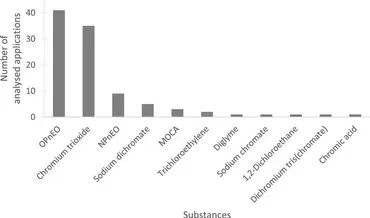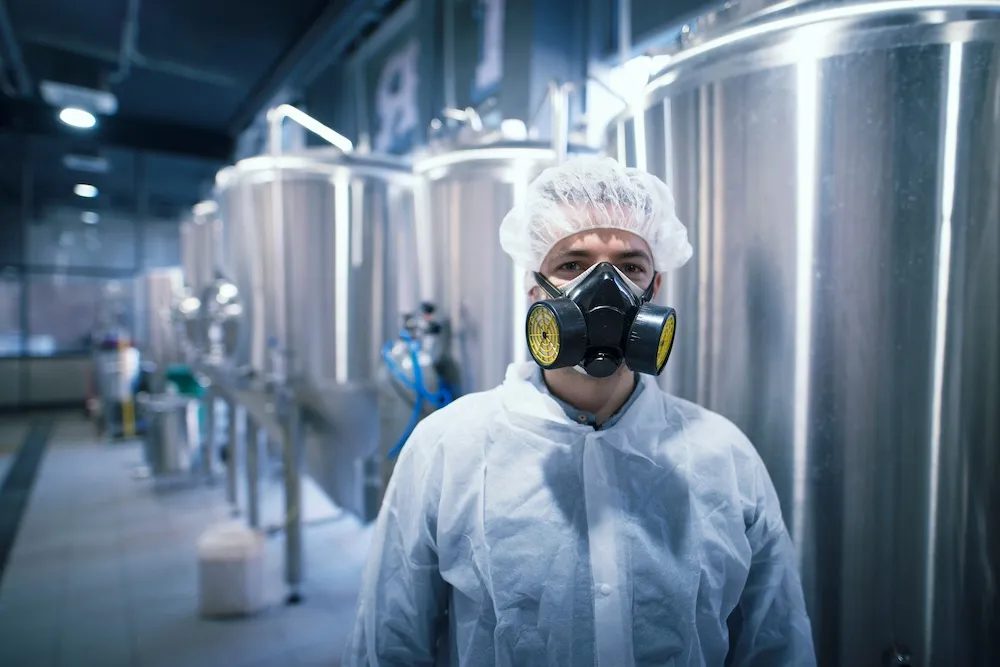
A recent study published in Frontiers in Toxicology assessed the application of the essential use concept to substances of very high concern (SVHCs) under the REACH (Registration, Evaluation, Authorization and Restriction of Chemicals) regulation.
This article explores the key findings and recommendations of a recent study on SVHCs.
Introduction: “essential use” concept
The importance of essentiality in European chemical policy
As part of the Green Deal, the European Commission (EC) announced its 2020 target for phasing out the substances most harmful to human health and the environment (unless their use is essential for society). The most harmful chemicals are defined as those classified as carcinogenic, mutagenic, toxic to reproduction, persistent, bioaccumulative, affecting the endocrine, immune, neurological or respiratory systems, and/or toxic to a specific organ.
Some scientists have suggested applying the “essential use concept” to certain harmful chemicals, to help improve the transparency and predictability of the regulatory process. This concept would apply to all relevant regulations, including REACH.
Presentation of the SVHC study under REACH
SVHCs are substances that are added to Annex XIV of the REACH regulation only when they are deemed a priority by ECHA. They are covered by the definition of the most harmful chemicals, as they are classified as:
- Carcinogenic
- Mutagenic or toxic for reproduction in categories 1A or 1B (CMR)
- Persistent, bioaccumulative and toxic (PBT)
- Very persistent and very bioaccumulative (vPvB)
- Endocrine disrupters (EDC)
- Chemicals of Equivalent Concern (REACH Article 57)
For this study, the researchers focused only on SVHCs subject to REACH authorization (Annex XIV), for which authorization applications have been submitted to the European Chemicals Agency (ECHA).
The researchers analyzed 100 uses of 11 SVHCs, including 4-(1,1,3,3-tetramethylbutyl)phenol (OPnEO) and chromium trioxide, which accounted for 42% and 35% of the cases studied respectively. These two SVHCs are used in critical sectors such as aerospace and defense, making their use essential in certain contexts. Here's an overview of the proportion of uses analyzed:

In this study, the researchers examined whether the technical function performed by SVHC, as described in the applications for authorization and in the context of its end use, corresponded to the essential use criteria defined by WSP (a company specializing in engineering, environmental consultancy and sustainability solutions, commissioned by the EC to produce a report in 2023 on the essential use concept for chemical substances in order to lay the foundations to guide the application of the essential use concept in chemical legislation).
Key results of the SVHC study
According to current essential use criteria, 55% of uses were deemed essential, 10% non-essential and 35% classified as “complex” due to the difficulty of assessing their essentiality.
This section will present the results of the SVHC study and the definitions of the various essential, non-essential and complex uses.
Essential uses for SVHC
Definition of essential: “A use was classified as ‘essential’ if the objective of the technical function of an SVHC for an end use met the essential use criteria, i.e. it was covered by the technical functions defined as essential in the WSP report. For example, if the sole purpose of the technical function of an SVHC used as a corrosion inhibitor was to ensure the safety of drinking water for all end uses (such as household taps), the use would be considered to meet the criterion “Prevention of [...] serious health problems”: Unsafe water and water safety. In this case, it was assumed that the safety of drinking water would be affected by the loss of the technical function provided by this SVHC and that, consequently, the use of the substance would be considered essential.”
SVHCs classified as essential represent 55% of the applications analyzed. The substances concerned are mainly the nonylphenols OPnEO and NPnEO.
SVHC uses deemed non-essential
Definition of non-essential: “In a ‘non-essential’ use case, the purpose of the technical function of an SVHC in an end-use does not meet any of the essential use criteria.”
SVHCs classified as non-essential represent 10% of the applications analyzed, suggesting that authorization could have been refused if the essential use criteria had been strictly applied. The substances identified are chromium trioxide (used in the automotive sector) and sodium dichromate (used in textile dyeing).
The complex uses of SVHC
Definition of complex: “A use was classified as ‘complex’ when it was not possible to reach a decision on a category due to, for example, a lack of information on the purpose of the technical function(s) provided by the SVHC and/or an inability to interpret the criteria, i.e. to decide whether the technical function meets the criteria of the WSP guideline.”
SVHCs classified as complex represent 35% of the applications analyzed. These uses cannot be identified as either essential or non-essential.
Challenges and recommendations on SVHC core criteria
The authors recommend that the European Commission develop clear guidelines for applicants and specify essential use criteria to facilitate the authorization process under REACH.
Difficulties in interpreting essentiality criteria
The study's analysis shows that the information provided in applications for authorization and the existing essential use criteria are not sufficient, leading to difficulties in assessing essentiality:
- Lack of clarity: Current essentiality criteria are sometimes ambiguous and lack specificity, which can lead to subjective interpretations and inconsistent decisions. Criteria, such as “necessary for health/safety” or “critical to the functioning of society”, require more precise definition.
- Insufficient data: Applications for authorization often lack clear information on the end products and technical functions of SVHCs, making it difficult to assess their essentiality.
ECHA calls for clearer guidelines and improvements
To improve the process, the author makes a number of recommendations:
1. Clear guidelines: Specific guidelines for applicants should be established in order to:
- Better assess the impacts of discontinuing the use of an SVHC on health, safety and the functioning of society.
- Provide additional end-product data to clarify the objectives of technical functions.
2. Concept of use as a service: It is suggested to go beyond the assessment of a substance's technical function to consider whether the service it provides could be replaced by a safer alternative.
3. Revision of use descriptors (ECHA):
- Harmonize terms describing technical functions to ensure greater consistency in assessments.
- Integrate a “services” approach to better describe the objectives of substances throughout their life cycle.
4. Integration of social perspectives:
- Include social data and behavioral science tools to understand citizens' values and priorities, and integrate these into the decision-making process.
- Promote greater transparency and citizen engagement to strengthen trust in regulatory decisions.
5. Consideration of economic impacts:
- Although economic evaluation is not part of the current essentiality criteria, it is recommended to balance short-term financial interests with long-term societal costs, including environmental and health impacts.
6. Clarity and simplification:
- Simplify the criteria by using terms such as “essential”, “necessary” and “critical” as synonyms, or develop an essentiality scale to better reflect different situations.
Conclusion of the Substances of Concern study
Summary of regulatory impacts and outlook
The application of essentiality criteria could be a powerful tool for prioritizing the elimination of harmful substances. However, adjustments are needed to improve the clarity of the criteria, integrate social perspectives, and better define the functions of substances. This would facilitate assessments and enhance the consistency and transparency of regulatory decisions.
Need regulatory support for your SVHC?
Don't hesitate to contact our experts!
A recent study published in Frontiers in Toxicology assessed the application of the essential use concept to substances of very high concern (SVHCs) under the REACH (Registration, Evaluation, Authorization and Restriction of Chemicals) regulation.
This article explores the key findings and recommendations of a recent study on SVHCs.
Introduction: “essential use” concept
The importance of essentiality in European chemical policy
As part of the Green Deal, the European Commission (EC) announced its 2020 target for phasing out the substances most harmful to human health and the environment (unless their use is essential for society). The most harmful chemicals are defined as those classified as carcinogenic, mutagenic, toxic to reproduction, persistent, bioaccumulative, affecting the endocrine, immune, neurological or respiratory systems, and/or toxic to a specific organ.
Some scientists have suggested applying the “essential use concept” to certain harmful chemicals, to help improve the transparency and predictability of the regulatory process. This concept would apply to all relevant regulations, including REACH.
Presentation of the SVHC study under REACH
SVHCs are substances that are added to Annex XIV of the REACH regulation only when they are deemed a priority by ECHA. They are covered by the definition of the most harmful chemicals, as they are classified as:
- Carcinogenic
- Mutagenic or toxic for reproduction in categories 1A or 1B (CMR)
- Persistent, bioaccumulative and toxic (PBT)
- Very persistent and very bioaccumulative (vPvB)
- Endocrine disrupters (EDC)
- Chemicals of Equivalent Concern (REACH Article 57)
For this study, the researchers focused only on SVHCs subject to REACH authorization (Annex XIV), for which authorization applications have been submitted to the European Chemicals Agency (ECHA).
The researchers analyzed 100 uses of 11 SVHCs, including 4-(1,1,3,3-tetramethylbutyl)phenol (OPnEO) and chromium trioxide, which accounted for 42% and 35% of the cases studied respectively. These two SVHCs are used in critical sectors such as aerospace and defense, making their use essential in certain contexts. Here's an overview of the proportion of uses analyzed:

In this study, the researchers examined whether the technical function performed by SVHC, as described in the applications for authorization and in the context of its end use, corresponded to the essential use criteria defined by WSP (a company specializing in engineering, environmental consultancy and sustainability solutions, commissioned by the EC to produce a report in 2023 on the essential use concept for chemical substances in order to lay the foundations to guide the application of the essential use concept in chemical legislation).
Key results of the SVHC study
According to current essential use criteria, 55% of uses were deemed essential, 10% non-essential and 35% classified as “complex” due to the difficulty of assessing their essentiality.
This section will present the results of the SVHC study and the definitions of the various essential, non-essential and complex uses.
Essential uses for SVHC
Definition of essential: “A use was classified as ‘essential’ if the objective of the technical function of an SVHC for an end use met the essential use criteria, i.e. it was covered by the technical functions defined as essential in the WSP report. For example, if the sole purpose of the technical function of an SVHC used as a corrosion inhibitor was to ensure the safety of drinking water for all end uses (such as household taps), the use would be considered to meet the criterion “Prevention of [...] serious health problems”: Unsafe water and water safety. In this case, it was assumed that the safety of drinking water would be affected by the loss of the technical function provided by this SVHC and that, consequently, the use of the substance would be considered essential.”
SVHCs classified as essential represent 55% of the applications analyzed. The substances concerned are mainly the nonylphenols OPnEO and NPnEO.
SVHC uses deemed non-essential
Definition of non-essential: “In a ‘non-essential’ use case, the purpose of the technical function of an SVHC in an end-use does not meet any of the essential use criteria.”
SVHCs classified as non-essential represent 10% of the applications analyzed, suggesting that authorization could have been refused if the essential use criteria had been strictly applied. The substances identified are chromium trioxide (used in the automotive sector) and sodium dichromate (used in textile dyeing).
The complex uses of SVHC
Definition of complex: “A use was classified as ‘complex’ when it was not possible to reach a decision on a category due to, for example, a lack of information on the purpose of the technical function(s) provided by the SVHC and/or an inability to interpret the criteria, i.e. to decide whether the technical function meets the criteria of the WSP guideline.”
SVHCs classified as complex represent 35% of the applications analyzed. These uses cannot be identified as either essential or non-essential.
Challenges and recommendations on SVHC core criteria
The authors recommend that the European Commission develop clear guidelines for applicants and specify essential use criteria to facilitate the authorization process under REACH.
Difficulties in interpreting essentiality criteria
The study's analysis shows that the information provided in applications for authorization and the existing essential use criteria are not sufficient, leading to difficulties in assessing essentiality:
- Lack of clarity: Current essentiality criteria are sometimes ambiguous and lack specificity, which can lead to subjective interpretations and inconsistent decisions. Criteria, such as “necessary for health/safety” or “critical to the functioning of society”, require more precise definition.
- Insufficient data: Applications for authorization often lack clear information on the end products and technical functions of SVHCs, making it difficult to assess their essentiality.
ECHA calls for clearer guidelines and improvements
To improve the process, the author makes a number of recommendations:
1. Clear guidelines: Specific guidelines for applicants should be established in order to:
- Better assess the impacts of discontinuing the use of an SVHC on health, safety and the functioning of society.
- Provide additional end-product data to clarify the objectives of technical functions.
2. Concept of use as a service: It is suggested to go beyond the assessment of a substance's technical function to consider whether the service it provides could be replaced by a safer alternative.
3. Revision of use descriptors (ECHA):
- Harmonize terms describing technical functions to ensure greater consistency in assessments.
- Integrate a “services” approach to better describe the objectives of substances throughout their life cycle.
4. Integration of social perspectives:
- Include social data and behavioral science tools to understand citizens' values and priorities, and integrate these into the decision-making process.
- Promote greater transparency and citizen engagement to strengthen trust in regulatory decisions.
5. Consideration of economic impacts:
- Although economic evaluation is not part of the current essentiality criteria, it is recommended to balance short-term financial interests with long-term societal costs, including environmental and health impacts.
6. Clarity and simplification:
- Simplify the criteria by using terms such as “essential”, “necessary” and “critical” as synonyms, or develop an essentiality scale to better reflect different situations.
Conclusion of the Substances of Concern study
Summary of regulatory impacts and outlook
The application of essentiality criteria could be a powerful tool for prioritizing the elimination of harmful substances. However, adjustments are needed to improve the clarity of the criteria, integrate social perspectives, and better define the functions of substances. This would facilitate assessments and enhance the consistency and transparency of regulatory decisions.
Need regulatory support for your SVHC?
Don't hesitate to contact our experts!







